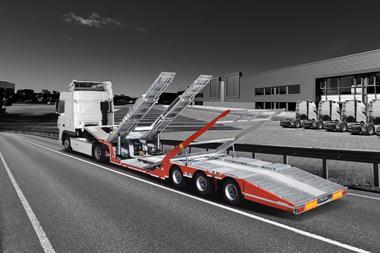[Updated October 31] There remain transport capacity shortages for finished vehicle movements in Europe, though it’s a mixed picture according to mode, according to executives from the Association of European Vehicle Logistics Providers (ECG), which held its annual conference in Hamburg, Germany last week. The overall message was that the situation has certainly improved compared to 2022.
Vehicle compounds remain full and managers are also dealing with the end-of-year volume peak but operators have learned to be much more flexible following the Covid pandemic, according to Wolfgang Göbel, president of ECG and head of logistics and services at German vehicle logistics provider Mosolf Group. He said that alongside a fixed network of compounds, there were now more satellite vehicle storage facilities, which enabled logistics providers to better manage volume variation.

Göbel also said that the road haulage sector was in more of an equilibrium for the moment after a more severe capacity shortage in recent years. He said the fluctuation in the availability of drivers will always be an issue for vehicle haulage firms as there is no likelihood of autonomous technology replacing them anytime soon.
However, there were a couple of complicating factors for the vehicle haulage sector.
Göbel referred to the revised VDI guidelines on vehicle lashing that came into force in September 1, 2024. The new regulations are for securing passenger cars as well as light and heavy commercial vehicles on vehicle transporters and they impose stricter requirements on load securing equipment to further enhance road safety. Transport providers are getting to grips with the new regulatory demands.
Costantino Baldissara, director of commercial logistics and operations at Grimaldi Group, and former ECG president, pointed to the average 40% increase in the cost of a road haulage equipment that can be incurred because of larger orders of 1,000+ being placed at equipment makers in the scramble for capacity. At the same time he referred to the investments that have been made in more modern road haulage fleets, with lower carbon emissions and a better fit for customers looking for more sustainable transport services.
Age and infrastructure on rail
However, rail services for finished vehicle shipments in Europe are in a more precarious position and continue to be plagued by infrastructure problems, particularly in Germany, where there is extensive ongoing repair and renovation work across the Deutsche Bahn freight rail network, which has reduced available capacity for goods movements by more than a third.
Rail services for vehicle transport is also affected by an ageing wagon fleet that is not up to standard for shipping newer, bigger and heavier finished vehicles, including those that are electric.
Göbel said that is encouraging new players into the market with different service models and a willingness to invest as older rolling stock is scrapped.
“We see more companies in the our industry starting to rent newer wagons on long- mid- or, short-term contracts,” he said, adding that other companies are building in this stock to their fleets and renting it out. The situation is improving but it is taking longer to establish more capacity because investment is replacing older wagons rather than building volume, and it does not get around the infrastructure problems and the impact on efficiency.
The ECG is playing its part in helping said Frank Schnelle, the ECG’s executive director and previously head of finished vehicle logistics at Glovis Europe. He pointed to the ECG’s new Rail Working Group to which OEMs are invited to collaborate and which is drawing big interest from them as they recognise the importance of securing capacity and reducing emissions.
Capacity at sea
Maritime finished vehicle services including short- and deep-sea shipping continue to suffer from capacity shortages and there are no signs of improvement, according to Baldissara.
Baldissara said the global fleet of ocean-going car carriers was down to around 750 vessels and available vessels moving vehicles between China and Europe are making four rotations a year because of longer transit times, up to 90 days, which was cutting capacity. Disruption to ocean services on Asia to Europe routes and renavigation around the African Cape mean that a vessel is moving on average 30,000 vehicles a year in a best-case scenario.
That pressure on capacity between Asia and Europe will be exacerbated if volumes from China, Korea and Japan continue to increase in coming years. Exports of battery EVs have been at record highs ahead of new tariffs imposed by the EU due to come into effect at the end of October. According to the ECG executive, this influx is unlikely to be dented by Chinese carmakers who can absorb the additional fees and still target consumers in Europe looking for more affordable EVs. At the same time, Frank Schnelle said the opportunity to build new EV factories in eastern Europe, in locations such as Hungary, would allow Chinese carmakers to focus on exporting hybrid EVs and combustion-engine vehicles, which still make up the vast majority of vehicle sales in Europe and are not subject to the same level of tariffs.
Chinese carmakers are reviewing their product, price and powertrain strategies for the EU and could either accelerate local production or use third party locations such as Turkey to navigate the tariffs.


























![Global[1]](https://d3n5uof8vony13.cloudfront.net/Pictures/web/a/d/s/global1_726550.svgz)













No comments yet